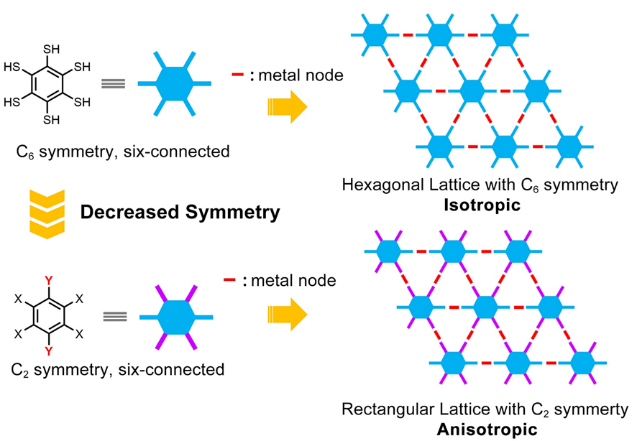Planar Carbon Lattices
RTG-2861-PCL
A1 - Synthesis, structure and transport properties of 2D c-MOFs
Principal investigator in the 1st cohort: Dr. Renhao Dong, TU Dresden, [webpage]
Doctoral researcher in the 1st cohort: Paul-Alexander Laval-Schmidt
Principal investigator in the 2nd cohort: Prof. Dr. Xinliang Feng, TU Dresden, [webpage]
Doctoral researcher in the 2nd cohort: Open position
Two-dimensional conjugated metal-organic frameworks, 2D c-MOFs, are an emergent class of carbon-based electronic materials with similar structural features to graphite, and in recent years have displayed high electrical conductivities (up to 2500 S/cm) for broad electronics-relevant functions. Single-layer 2D c-MOFs with a Kagome lattice have been predicted theoretically to exhibit Dirac nature.[1] To date, only around twenty 2D c-MOFs have been reported based on planar polycyclic aromatic ligands with symmetrical functional groups (-OH, -NH2, -SH).[2] An essential question is how to develop the chemistry of 2D c-MOFs enabling enormous chemical and structural diversity, which further allows one to fine-tune the electroactive properties. Another challenge is how to achieve highly crystalline 2D c-MOF monolayers.[3] Most reported cases are often polycrystalline powders or films comprising local defects and random crystallites. Such structural heterogeneity makes it challenging to establish reliable structure-property relationships.

Figure: Proposed multicomponent rectangular 2D c-MOFs with in-plane anisotropy. X = SH, OH, NH2. Y = SH, OH, NH2. X ≠ Y.
Thesis topic 1st cohort: Synthesis of multicomponent 2D c-MOFs with atomic precision
We will synthesize a low-symmetry ligand family named as “4+2” ligands and develop new multicomponent 2D c-MOFs with in-plane anisotropic 2D lattices (Figure), which are not commonly observed in the synthetic 2D materials. “4+2” ligands are a group of benzene-derived ligands, in which all six hydrogens are substituted with strong donor groups, and two donor groups locating at the para positions are different from the other four ones, thus exhibit limited mirror symmetry (with Golze. We will explore the electronic properties that can be tailored by precisely tuning the atomic position.
Thesis topic 2nd cohort: Development of 2D c-MOF monolayers with unique spin-related properties
[2] C. Yang, R. Dong, M. Wang, P. Petkov, Z. Zhang, M. Wang, P. Han, M. Ballabio, S. Bräuninger, Z. Liao, J. Zhang, F. Schwotzer, E. Zschech, H. Klauss, E. Cánovas, S. Kaskel, M. Bonn, S. Zhou, T. Heine, X. Feng, “A Semiconducting Layered Metal-Organic Framework Magnet”, Nat. Commun. 2019, 10, 3260.
[3] R. Dong, M. Pfeffermann, H. Liang, Z. Zheng, X. Zhu, J. Zhang, X. Feng, “Large-Area, Free-Standing, Two-Dimensional Supramolecular Polymer Single-Layer Sheets for Highly Efficient Electrocatalytic Hydrogen Evolution”, Angew. Chem. Int. Ed. 2015, 54, 12058-12063.
